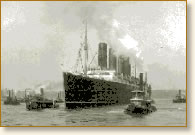Thursday, April 1, 2010
Works Cited
*3*2*1
- The Armenian Genocide was known as the "first modern genocide."
- Austria-Hungary was split into Austria and Hungary after WWI.
- After the War, Germany was sole responsible for the war.
2 Things I Thought were Interesting:
- The USA did not support the League of Nations.
- After the war, Japan felt like they didn't get what they earned and thought the USA was racist.
1 Question I still Have:
- After WWI, Germany had to pay $33 billion in reparations, how did they afford to participate in WWII?
Spotlight On: The Armenian Genocide
Events of WWI
At 2:10 in the afternoon on May 7, German U-boats fired a torpedo at the Lusitania. Lifeboats Crashed into the sinking ship and crushed a crowded deck full of passengers. Within eighteen minutes, the ship had sunk. 1,119 of the 1924 passengers were claimed dead, 114 of those being American. Because of the sinking Americans were enraged, two years later American declared war.
In January of 1917 British cryptographers deciphered a note from German Foreign Minister, Arthur Zimmerman. According to the note, it stated that they(as in Germany) would help Mexico gain territory from the U.S. if they would join Germany's alliance. The note was then published to increase the support of bringing the U.S. into WWI. The note had such an impact, Americans joined war.
*Connection Across Time*
Both the sinking of the Lusitania and the Zimmerman Note had an impact on history as we know it. Without these two U.S. events, the United States would have never been brought into WWI. Where would the allied powers be then? Would we have won the war? Without those events, history today wouldn't exist. My connection across time is simple. Both the sinking of the lusitania and the zimmerman note formed what we have today and that is peace with Germany.
Monday, March 29, 2010
Significant People of WWI
 Gavrilo Princip was important during WWI because he was the person who assassinated Franz Ferdinand. He shot at the archduke from five feet away, and hit him in the neck and his wife in the abdomen. After the shooting, Princip then turned the gun upon himself but was seized and arrested.
Gavrilo Princip was important during WWI because he was the person who assassinated Franz Ferdinand. He shot at the archduke from five feet away, and hit him in the neck and his wife in the abdomen. After the shooting, Princip then turned the gun upon himself but was seized and arrested. Following the assassination of Franz Ferdinand, Kaiser Wilhelm II incited Austria-Hungary to prepare war against Serbia. Not thinking of the consequences of a future war, he pulled Britain, Russia, and France into the war as well. Nevertheless, Germany's ability to win the war in 1918 collapsed when the U.S. became involved and Germany experienced shortages and was evidently spinning out of control, Germany was set to lose the war.
Following the assassination of Franz Ferdinand, Kaiser Wilhelm II incited Austria-Hungary to prepare war against Serbia. Not thinking of the consequences of a future war, he pulled Britain, Russia, and France into the war as well. Nevertheless, Germany's ability to win the war in 1918 collapsed when the U.S. became involved and Germany experienced shortages and was evidently spinning out of control, Germany was set to lose the war.Sunday, March 28, 2010
Art Pieces of WWI
The Filling Factory
This art piece was illustrated by Charles Ginner in 1918. This illustration shows how because of the war, women were used in the factories to do the jobs of men.
This art piece, Gassed illustrated by John Singer Sargent in 1918, shows the new weapons of war, in this case, poison gas.
 This art piece illustrated by Roger de la Fresnaye is called L'artillerie(Artillery) in 1911. It shows just how war was fought with weapons.
This art piece illustrated by Roger de la Fresnaye is called L'artillerie(Artillery) in 1911. It shows just how war was fought with weapons.
This art piece is from an unknown illustrator, i did everything I could to find the illustrator and even a name but he or she was unknown. I had to use this art piece because it showed just how combat warfare was in trenches, also known as Trench Warfare.
 This art piece, No Entry was illustrated by Georges Scott in 1914 to depict how brave the men of our nations were to defend their country, and help put an end to war.
This art piece, No Entry was illustrated by Georges Scott in 1914 to depict how brave the men of our nations were to defend their country, and help put an end to war.Thursday, March 25, 2010
Chapter Introduction!

- In World War I, countries were separated by the Allies and the Central Powers. Allies consisted of:
- Great Britain
- Italy
- Russia
- France
- Japan
- Central Powers consisted of:
- Germany
- Austria-Hungary
- Bulgaria
- Ottoman Empire
World War I had the "domino effect", by that I mean Germany declares war on Russia, Germany declares War on France, Germany invades Belgium, Great Britain declares War on Germany, and so on.
WWI was by far an incredible significance as to the many men lost, materials used, the downfall of empires, and most importantly the setting of World War II.





